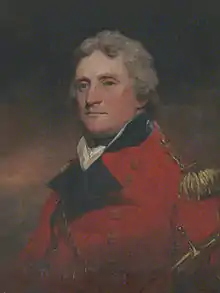Hildebrand Oakes
Lieutenant-General Sir Hildebrand Oakes, 1st Baronet, GCB (19 January 1754 – 9 September 1822) was a British Army officer.
Sir Hildebrand Oakes | |
|---|---|
 Sir Hildebrand Oakes | |
| Born | 19 January 1754 Exeter, Devon |
| Died | 9 September 1822 (aged 68) London |
| Allegiance | |
| Service/ | |
| Years of service | 1767–1822 |
| Rank | Lieutenant General |
| Commands held | Malta garrison |
| Battles/wars | American War of Independence Egyptian Campaign |
| Awards | Knight Grand Cross of the Order of the Bath |
Military career
Oakes was commissioned into the 33rd Regiment of Foot in 1767 and served in the American War of Independence under Lord Cornwallis.[1] He became deputy quartermaster-general in Corsica in May 1794, quartermaster-general in the Mediterranean in June 1794 and quartermaster-general in Portugal in December 1796.[1] He served in the Egyptian Campaign in 1800 as second-in-command under Sir John Moore.[1] He went on to be brigadier-general at Malta in October 1802, Lieutenant-Governor of Portsmouth and General Officer Commanding South-West District in November 1804[2] and a commissioner of military inquiry in June 1805.[1] After that he became quartermaster-general in the Mediterranean in July 1806, commander of the Malta garrison in March 1808 and Civil Commissioner of Malta in May 1810.[1]
In his final months as Civil Commissioner of Malta, Oakes was responsible for dealing with a plague epidemic that devastated the islands. Prior to the outbreak of the disease, Oakes had already expressed his wish to resign the post on the grounds of his own poor health. He took measures to contain the epidemic, and by the time he left office on 5 October 1813 the epidemic had begun to subside. He was the last person to hold the office of Civil Commissioner, since his successor Thomas Maitland was given the title of Governor of Malta (a post which had been offered to Oakes but which he had declined).[3]
He was appointed Lieutenant-General of the Ordnance in January 1814 and died in office in that post.[1]
Oakes was also colonel of the 52nd Regiment of Foot.[4]
Family
In 1818, Oakes' daughter Antonia married John Wildman, younger brother of Colonel Thomas Wildman.[5]
References
- Oxford Dictionary of National Biography
- "No. 15752". The London Gazette. 6 November 1804. p. 1367.
- Grech, Chris (27 October 2013). "Sir Hildebrand Oakes' resignation as Governor of Malta in 1813". Times of Malta. Archived from the original on 14 March 2020.
- Debrett's Baronetage of England
- Dalton, Charles (1904). The Waterloo roll call. With biographical notes and anecdotes. London: Eyre and Spottiswoode. p. 67.
| Political offices | ||
|---|---|---|
| Preceded by Sir Alexander Ball |
Civil Commissioner of Malta 1810–1813 |
Succeeded by Sir Thomas Maitland (Governor) |
| Military offices | ||
| Preceded by John Whitelocke |
GOC South-West District 1804–1805 |
Succeeded by John Hope |
| Preceded by Sir John Moore |
Colonel of the 52nd (Oxfordshire) Regiment of Foot 1809–1822 |
Succeeded by Sir George Walker |
| Preceded by Sir Thomas Trigge |
Lieutenant-General of the Ordnance 1814–1822 |
Succeeded by The Lord Beresford |
| Baronetage of the United Kingdom | ||
| New creation | Baronet (of the Army) 1813–1822 |
Extinct |
| Baronet (of Hereford) 1815–1822 |
Succeeded by Sir Henry Oakes | |
